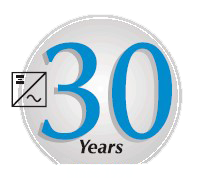Imagine having bought a pure sine wave inverter to power your devices when there’s no electricity. You are all excited about it and have hooked up your devices to it.
You have even properly connected the inverter to your DC power source. However, nothing happens when you switch on the inverter. There is no power, and the inverter switches off, and this disappoints you.
It makes you wonder what went wrong and what you should do.
Nothing done wrong
First of all, it’s not likely that there’s something wrong with the inverter. You have done everything right.
You have taken the time to connect the inverter to a power source with the right voltage and cables. Well, what may have happened is that the inverter may have gone into overload.
Switching off is a safety feature.
It’s often because of the high starting surge from the devices it’s connected to. And the inverter switching off is a safety feature of pure sine inverters.
If you wonder why, well, it’s because pure sine wave inverters have an overload protection feature.
According to this feature, the inverter automatically switches off if it overloads. By switching off, the inverter helps prevent possible damage to both the inverter and devices.
The chances of the inverter switching off are higher if you plug in tools or appliances with a combined surge rating equal to or higher than the inverter’s power capacity.
Choose an accommodating inverter.
Remember, you always have to buy an inverter that can accommodate the total power of all the devices it will connect to and power. It should not only provide enough power for the appliances but also it’s starting current.
Appliances that have high surge requirements
If you wonder what starting current is, well, it’s the initial power burst that some appliances use to start up. However, not all devices have a high starting current.
It’s usually appliances with motors, air compressors, and some lighting equipment like halogen lamps that have a high starting current. Examples for appliances with motors are refrigerators, air conditioners, electric saws, water pumps, and laser printers.
So you have to be extra careful about your power requirements and inverter capacity if your sine wave inverter will be powering any of these appliances.
How to ascertain an appliance’s surge power rating
Once you know about an appliance’s surge power rating, the next question to come to mind is wondering how you can ascertain it. Besides, you can even avoid all this inconvenience by knowing the surge power rating of the appliances your inverter will be powering.
You can do it in two ways.
The first option is to measure using the help of an inrush current meter. The second option you have is to ask the appliance manufacturers for it. Don’t forget; you can always check the appliance’s specs because the surge rating is sometimes listed.
How to avoid overloading
The best and most practical way to prevent overloading in inverters is by overseeing. It means you should not buy an inverter with a power output rating equal to the continuous power and surge power rating of the appliances you plan to use.
Instead, look for pure sine wave inverters with a power rating that’s significantly higher than the appliances’ combined power and surge power rating. This way, you invest in an inverter that won’t overload and can also power multiple smaller devices.
Now that you know all about overloading in inverters, and how you can prevent it, you can avoid unnecessary overloads. The inverters will, in turn, provide uninterrupted power when you need it the most.




